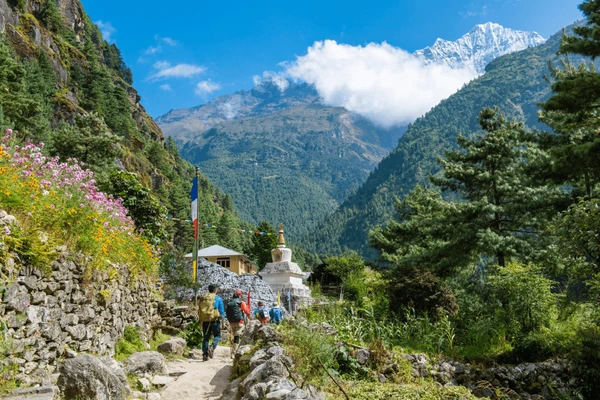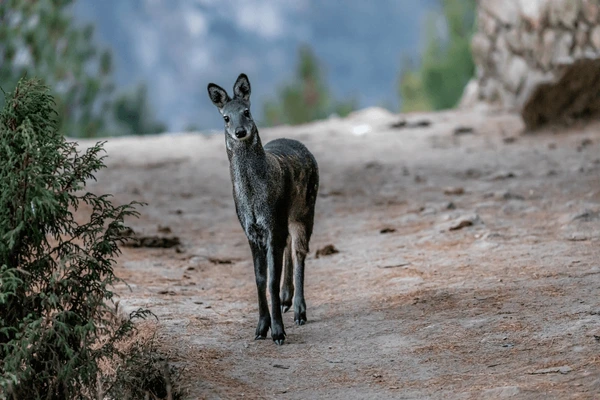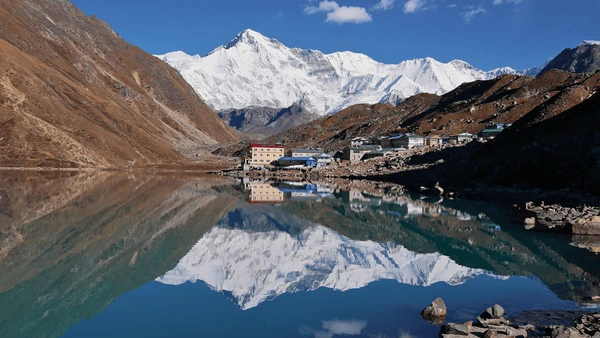Deep into the Everest region lies Sagarmatha National Park, a spiritual home to the Sherpa people and a Himalayan haven for endangered wildlife.
This Himalayan National Park is a protected area that acts as the heart of the Himalayan wilderness.
The park covers an area of 1,148 sq km, stretching from lush valleys to Everest, the highest mountain in the world.
Moreover, the National Park is renowned for its breathtaking scenery, rich Sherpa culture and unique wildlife.
You will hike through rhododendron and pine forests and explore traditional Sherpa villages in the lower part of the region.
In the upper section, you will be surrounded by snow-covered peaks and barren rocks, which will leave you speechless.
So, are you ready to create memories that will bring a smile to your face?
From the Everest base camp trek to the Everest expedition (Mount Everest Climbing), we have amazing packages waiting for you.
Where is Sagarmatha National Park located?

Sagarmatha National Park lies in the Solukhumbu district in the north-eastern part of Nepal.
Sagarmatha National Park’s elevation ranges from 2,845 meters to 8,848.86 meters above sea level, consisting of villages like Namche Bazaar, Dingboche and others.
It shares its northern boundary with Qomolangma National Nature Preserve in Tibet, an autonomous region of China.
To the east lies Makalu Barun National Park, while it goes to Dudh Kosi River in the south.
Sagarmatha National Park History
The Sagarmatha National Park Nepal was established in 1976.
It was created to protect and safeguard the region’s rich biodiversity.
In 1979, UNESCO recognized the park’s importance and declared it a UNESCO World Heritage Site.
Further down the line, in 2002, a buffer zone with 275 sq kilometers area was added to reduce the impact of tourism and human activities.
Before Sagarmatha National Park’s establishment, the region was already a magnet for mountaineering expeditions.
The historic milestone was when Sir Edmund Hillary and Tenzing Norgay Sherpa reached the summit of Mt Everest in 1953.
This achievement resulted in the Everest region coming into the spotlight.
Current activities in park management include wildlife management, habitat restoration and sustainable tourism promotion.
Local communities are also involved in the development process.
They ensure the process coincides with environmental preservation and respect for cultural integrity.
Sagarmatha National Park Facts
Here, we will discuss about 5 facts about Sagarmatha National Park, which are:
- Sagarmatha National Park is Nepal’s first park to be listed as a UNESCO World Heritage Site in 1976.
- The National Park houses some of the tallest mountains in the world, such as Mt Everest, Lhotse, Cho Oyu and others.
- The park has been a mountaineering center since the historic milestone of Sir Edmund Hillary and Tenzing Norgay’s ascent of Everest.
- Sagarmatha National Park is considered one of the most important areas in the world for scientific studies of glaciers and climate change.
- For generations, the region has been heavily influenced by Tibetan Buddhism.
How to Reach Sagarmatha National Park?

Adventurers venturing on Everest expeditions will hike through Sagarmatha National Park.
You can reach Sagarmatha National Park in three different ways:
Lukla flight and Trek to Namche Bazaar
- This is the most common route for trekkers to reach the Everest region.
- First, you will take a flight from Kathmandu to Lukla Airport, which takes about 30 minutes. Then, you will trek for 2 days to reach Namche Bazaar, the main gateway to Sagarmatha National Park.
- You will hike through dense lush forests, traditional villages and suspension bridges over the Dodh Koshi River.
- Interact with local people and understand their traditions and way of life.
Helicopter Flight to Sagarmatha National Park
- The helicopter ride is the perfect way to reach Sagarmatha National Park, taking around 1.5-2 hours.
- You can enjoy panoramic views of Mount Everest, Khumbu Glacier and surrounding majestic peaks.
- Bypass all the physical stress of trekking from Lukla and arrive at key locations within the park
Road journey to Jiri and Trek to Sagarmatha National Park
- Want a more immersive trekking experience? Then this route is perfect for you.
- Our Jiri Everest Base Camp trek package takes you through this route.
- You will dive from KTM to Bhandara followed by 8 days of trekking to reach Namche Bazaar, a bustling town within Sagarmatha National Park.
- Experience the remote villages, deep valleys and spectacular mountain landscapes as you trek.
- While venturing through this route, you’ll see fewer crowds, offering you solitary and quieter trekking experiences.
Popular Trekking Routes in Sagarmatha National Park
Everest Base Camp Trek
Duration: 7-21 days
Highlights:
- Step foot at the base camp of Everest.
- Enjoy 360-degree panoramic views of Everest, Cho Oyu and other Himalayan peaks.
- View the spectacular Khumbu Icefall and Glacier.
- Explore traditional Sherpa villages and get insights into the Sherpa culture and traditions.
- Hike beyond the iconic EBC to the Advanced base camp, reaching an altitude of 6,400 meters.
- Choose from diverse Everest trekking packages that suit your time.
Gokyo Trek
Duration: 13-20 days
Highlights:
- Observe the beautiful and peaceful environment of Gokyo Lakes.
- Reach the highest point of the Gokyo Lake trek, Gokyo Ri to look at the spectacular views of Gokyo Lakes.
- Witness the picture-perfect scenery of mountains such as Ama Dablam and Cho Oyu.
- Engage with local sherpa people and learn about their traditions and way of living.
Sailung Trek
Duration: 11 days
Highlights:
- Trek through the less-traveled route, offering quieter and more peaceful trekking on this Sailung trek.
- Enjoy breathtaking views of the Himalayas such as Everest, Lhotse and Makalu.
- Discover the rich biodiversity that the Sagarmatha National Park offers, including flora and fauna.
- Walk through diverse landscapes, from rhododendron forests to high-altitude deserts.
Flora and Fauna in Sagarmatha National Park

Sagarmatha Park houses various flora and fauna, which give color and life to its rigid landscape.
The flora depicts how plant species adapt to extreme altitudes and varied climates.
While trekking through the park, you can observe various ecosystems, from dense lush forests in the lower areas to hard alpine shrubs in the higher regions.
This national park offers a chance to encounter rare species of birds and animals.
Each form of wildlife plays an important role in adding to the richness of biodiversity of the park.
Plant Species
- Rhododendrons
- Pine
- Junipers
- Rare Alpine Plants
Animal Species
- Rare Panda
- Snow Leopard
- Himalayan Tahr
- Musk Deer
Bird Species
- Himalayan Monal
- Blood Pheasant
- Snowcock
Best Time to Trek to Sagarmatha National Park
The best time to undertake the Sagarmatha National Park trek is in the spring (March-May) and autumn periods (September to November).
In these times, the most appropriate weather prevails with clearer skies and beautiful views.
Spring Season (March-May):
The famous time for the Everest BC trek is in spring.
This is because the weather will be neither volatile nor too harsh.
Additionally, the temperatures are mild, making the time perfect to trek Sagarmatha National Park.
The trails will color up with blooming rhododendrons and other wildflowers.
Mountain peaks such as Everest, Nuptse and Ama Dablam are seen in their most impressive views.
Autumn season (September-November):
Autumn is the best season for Sagarmatha National Park trekking.
During this time, the trails are dust-free and the skies are clear.
The mountains will be beautifully covered in snow.
Sagarmatha National Park trail is easy to navigate as the weather is cool for the trekkers.
Trekkers from all over the world are jostling their way up the trail.
Sagarmatha trek in October stands out due to crisp, clear skies and panoramic views of the Himalayas.
Packing Lists for Sagarmatha National Park Trekking
Trekking to the Sagarmatha region is definitely worth your time.
But to make the most out of your adventure, you should pack the right gear for trekking to the Everest region.
Here is the list of things you should pack:
Document
- Nepal visa
- Passport copies and photos
- Travel Insurance
- Permits
Clothing
- Thermal base layers
- Waterproof and windproof shell
- Buff
- Fleece jacket
- Warm hat and sun hat
- Quick-dry towel
- Insulated down jacket
- Trekking pants
- Trekking shorts
Footwear
- Sturdy Hiking boot
- Moisture-wicking socks
- Sandal
- Sport shoe
Sleeping Essentials
- Sleeping bag
- Inflatable pillow
Trekking Equipment
- Trekking poles
- Headlamp
- Backpack with rain cover
- Duffel bag
Hydration and Nutrition
- Water bottle
- Water purification tablets
- High energy snacks
Accessories
- Powerbank and charger
- First aid kit
- Medicines for altitude sickness
- Camera
- Local Cash
- UV protection sunglasses
- Sunscreen and lip care
- Personal hygiene kit (brush, paste and wet wipe)
Cultural Significance of Sagarmatha National Park

Much more than natural beauty, there is a rich Sherpa cultural heritage that enriches Sagarmatha National Park.
Traditional practices combined with spiritual beliefs and daily life fuse with the mighty Himalayas.
The national park houses the Sherpa people, renowned for strength, bravery and mountaineering expertise.
People in the past used to trade goods with Tibet, hence the region is highly influenced by Tibetan Buddhism.
You can visit ancient Buddhist monasteries throughout the region, especially the Tengoboche monastery, which holds great spiritual significance.
Visiting Namche Cultural Museum will provide insights into the history, way of life, and Sherpa’s relations with nature.
The park offers a host of cultural events: festivals and rituals of Sherpas and Buddhists.
Events like Losar, a Tibetan New Year, and Saga Dawa attract locals and visitors with traditional dances, religious functions, and communal feasting.
Main Attractions and Highlights of Sagarmatha National Park

Sagarmatha National Park Nepal, is known to everyone for its rich natural and cultural landmarks.
Every single one of them offers nature lovers, adventurers and enthusiasts very different experiences.
Given below are some attractions and highlights that you can experience:
Everest Base Camp
- Reach the final destination of the Everest Base Camp trek in Sagarmatha National Park, which is situated at 3,664 meters above sea level.
- Observe breathtaking panoramic views of Everest and its surrounding mountains.
Gokyo Lakes and Dodh Koshi River
- Gokyo Lakes comprise turquoise-colored high-altitude alpine lakes with Himalayan peaks in the surroundings.
- View some breathtaking sights of Mount Everest, among other towering peaks, from the top of Gokyo Ri.
- Gokyo Lakes showcases spectacular views of Sagarmatha National Park, making it ideal for both photographers and trekkers alike.
- Dudh Kosi River is otherwise known as the “Milk River“, as milky waters originate from Khumbu Glacier.
- Cross high suspension bridges over roaring rivers, giving thrilling sensation and taking stunning pictures.
Ancient Buddhist Monastery
- Explore the rich spiritual and cultural aspects of Tengboche Monastery at 3,867 meters above sea level.
- Observe Buddhist prayer flags and a panoramic view of the Himalayan ranges.
Traditional Villages
- Visit villages like Namche Bazaar and Khumjung, with their traditional Sherpa way of life and warm hospitality.
Sagarmatha National Park Museum
- This museum is located at Namche Bazaar, the hub of the most energetic Sherpa village functioning as a gateway to Sagarmatha National Park.
- Allows guests to gain a deep understanding of Sherpa lifestyles and the spiritual significance of the region, thus, increasing their knowledge through the trek.
- The museum is equally valid for those interested in both history and nature.
Preparation Tips for Visiting Sagarmatha National Park
- Pack layers for cold weather: Volatile weather and temperature require carrying thermal layers, waterproof jackets and warm headgear accessories to help people fight the cold.
- Endurance training: Engage your body in workout and hiking activities with a loaded backpack.
- Acclimatization Time: Take extra days in Namche Bazaar or other stops for high-altitude acclimatization.
Doing so will give you time to adjust your body to increasing altitude and decreasing oxygen rate.
- Go during the right season: Spring and Autumn have clear weather and are considered ideal for trekking.
- Obtain permits: Before heading for the trek, you should get permits such as the Sagarmatha National Park Entry Permit and the Pasang Lhamu Khumbu Municipality Permit.
- Medicines: First-aid kit with medicine, painkillers and basic medicine for altitude sickness. Keep bandages too.
- Respect the culture of the locals: Be sensitive to Sherpa customs while visiting monasteries or other sacred sites.
Dress modestly and do not take pictures of the sacred sites without asking for permission.
- Altitude sickness awareness: Watch for symptoms such as headaches or nausea and prepare for a descent if the symptom prolongs.
- Reduce plastic use and pack out trash: Don’t leave the trash and waste on the trail and any other sites during your Sagarmatha adventures.
Use reusable water bottles and ensure the garbage is properly taken care of.
Conclusion
Sagarmatha National Park is a UNESCO World Heritage Site that offers a fantastic blend of rich biodiversity, Sherpa heritage and natural beauty.
Trekking to Sagarmatha Park is a life-changing odyssey, offering you the opportunity to walk through beautiful forests, cross high-suspension bridges and navigate tough terrains.
Every step will reveal breathtaking Himalayan landscapes, from terraced fields to towering snow-capped peaks.
With Bold Adventures, you can venture on Sagarmatha adventures with confidence.
Contact Bold Adventures and let us guide you on this journey, representing safety, unforgettable experiences and expert support every step of the way.
FAQs
In which district Sagarmatha National Park lies?
Sagarmatha National Park lies in the Solukhumbu district, northeastern part of Nepal.
What is the height of Sagarmatha National Park?
Sagarmatha National Park’s height ranges from 2,840 meters to 8,838.86 meters.
Which airport is closest to Sagarmatha National Park?
Tenzing-Hillary Airport, also known as Lukla Airport is the closest airport to Sagarmatha National Park.
What are the required permits for Sagarmatha National Park?
You require these two permits for Sagarmatha National Park trekking:
Khumbu Rural Municipaity Permit
Sagarmatha National Park Entry Permit
Do I need a trekking guide for Sagarmatha National Park trekking?
Yes, you need a trekking guide for Sagarmatha National Park treks.
The government of Nepal made it mandatory for foreigners to hire a trekking guide while trekking as of 2023.


Recent Comments